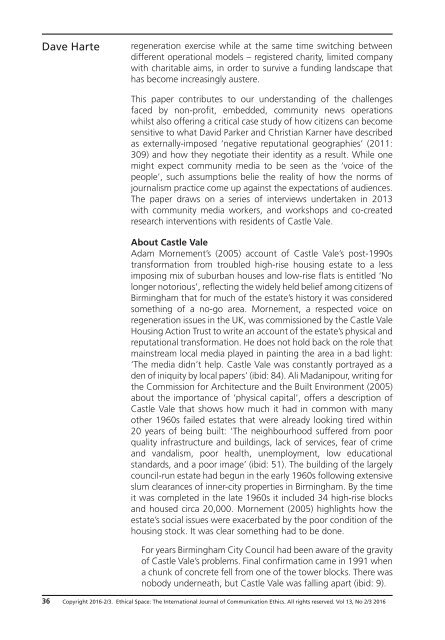Beyond clickbait and commerce
v13n2-3
v13n2-3
You also want an ePaper? Increase the reach of your titles
YUMPU automatically turns print PDFs into web optimized ePapers that Google loves.
Dave Harte<br />
regeneration exercise while at the same time switching between<br />
different operational models – registered charity, limited company<br />
with charitable aims, in order to survive a funding l<strong>and</strong>scape that<br />
has become increasingly austere.<br />
This paper contributes to our underst<strong>and</strong>ing of the challenges<br />
faced by non-profit, embedded, community news operations<br />
whilst also offering a critical case study of how citizens can become<br />
sensitive to what David Parker <strong>and</strong> Christian Karner have described<br />
as externally-imposed ‘negative reputational geographies’ (2011:<br />
309) <strong>and</strong> how they negotiate their identity as a result. While one<br />
might expect community media to be seen as the ‘voice of the<br />
people’, such assumptions belie the reality of how the norms of<br />
journalism practice come up against the expectations of audiences.<br />
The paper draws on a series of interviews undertaken in 2013<br />
with community media workers, <strong>and</strong> workshops <strong>and</strong> co-created<br />
research interventions with residents of Castle Vale.<br />
About Castle Vale<br />
Adam Mornement’s (2005) account of Castle Vale’s post-1990s<br />
transformation from troubled high-rise housing estate to a less<br />
imposing mix of suburban houses <strong>and</strong> low-rise flats is entitled ‘No<br />
longer notorious’, reflecting the widely held belief among citizens of<br />
Birmingham that for much of the estate’s history it was considered<br />
something of a no-go area. Mornement, a respected voice on<br />
regeneration issues in the UK, was commissioned by the Castle Vale<br />
Housing Action Trust to write an account of the estate’s physical <strong>and</strong><br />
reputational transformation. He does not hold back on the role that<br />
mainstream local media played in painting the area in a bad light:<br />
‘The media didn’t help. Castle Vale was constantly portrayed as a<br />
den of iniquity by local papers’ (ibid: 84). Ali Madanipour, writing for<br />
the Commission for Architecture <strong>and</strong> the Built Environment (2005)<br />
about the importance of ‘physical capital’, offers a description of<br />
Castle Vale that shows how much it had in common with many<br />
other 1960s failed estates that were already looking tired within<br />
20 years of being built: ‘The neighbourhood suffered from poor<br />
quality infrastructure <strong>and</strong> buildings, lack of services, fear of crime<br />
<strong>and</strong> v<strong>and</strong>alism, poor health, unemployment, low educational<br />
st<strong>and</strong>ards, <strong>and</strong> a poor image’ (ibid: 51). The building of the largely<br />
council-run estate had begun in the early 1960s following extensive<br />
slum clearances of inner-city properties in Birmingham. By the time<br />
it was completed in the late 1960s it included 34 high-rise blocks<br />
<strong>and</strong> housed circa 20,000. Mornement (2005) highlights how the<br />
estate’s social issues were exacerbated by the poor condition of the<br />
housing stock. It was clear something had to be done.<br />
For years Birmingham City Council had been aware of the gravity<br />
of Castle Vale’s problems. Final confirmation came in 1991 when<br />
a chunk of concrete fell from one of the tower blocks. There was<br />
nobody underneath, but Castle Vale was falling apart (ibid: 9).<br />
36 Copyright 2016-2/3. Ethical Space: The International Journal of Communication Ethics. All rights reserved. Vol 13, No 2/3 2016


